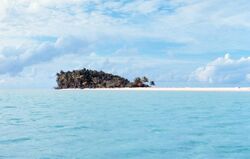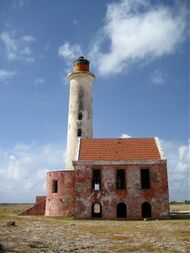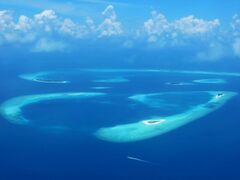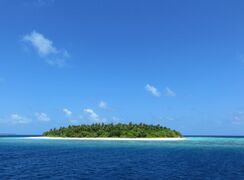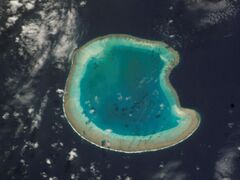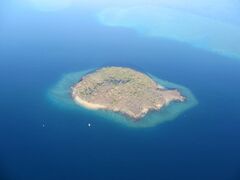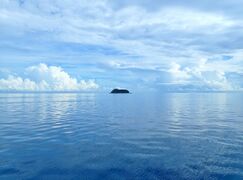Desert island
A deserted island or uninhabited island is an island that is not permanently populated by humans. Uninhabited islands are often used in movies or stories about shipwrecked people, and are also used as stereotypes for the idea of "paradise". Some uninhabited islands are protected as nature reserves and some are privately owned. Devon Island in Canada is claimed to be the largest uninhabited island in the world.
Small coral atolls or islands usually have no source of fresh water, but at times a fresh water lens (Ghyben–Herzberg lens) can be reached with a well.
Terminology
Uninhabited islands are sometimes also called "deserted islands" or "desert islands". In the latter, the adjective "desert" connotes not desert climate conditions, but rather "desolate and sparsely occupied or unoccupied". The word "desert" has been "formerly applied more widely to any wild, uninhabited region, including forest-land", and it is this archaic meaning that appears in the phrase "desert island".[1] Similarly, the term "deserted island" does not imply that the island was previously inhabited and later deserted.[citation needed]
The term "desert island" is also commonly used figuratively to refer to objects or behavior in conditions of social isolation and limited material means. Behavior on a desert island is a common thought experiment, for example, "desert island morality".[1]
List of some currently uninhabited islands
- Appat Island, Greenland
- Kermadec Islands in the South Pacific, part of New Zealand
- Astola Island, Pakistan
- Auckland Islands, New Zealand
- Blasket Islands, County Kerry, Ireland
- Devon Island, 55,247 km2, largeSt uninhabited island of the world.
- Many small islands off the coast of Greece[2]
- A majority of the Barra Isles, the Outer Hebrides, Scotland. The most famous of these is Barra Head.
- Ball's Pyramid, a tall volcanic mountain located far from other islands in the Pacific Ocean
- Most of the Bonin Islands in Japan
- Caquorobert, Guernsey
- Chacachacare, Trinidad and Tobago
- Coral Sea Islands off the northeastern coast of Australia
- De Long Islands in the Arctic Ocean, part of Russia
- Most of the Canadian Arctic Archipelago
- Clipperton Island
- Many islands in the Maldives
- Ogurchinsky Island, Caspian Sea
- Korzhin Island, Lake Balkhash
- Most of the Phoenix Islands, part of Kiribati
- Heard Island and McDonald Islands
- Some of the Orkney Islands
- Many islands off the coast of Labrador
- Many islands in Lake Nipigon
- Some of the San Juan Islands
- Santa Luzia, Cape Verde
- Skellig Michael
- Kaffeklubben Island, Greenland
- Surtsey
- Lítla Dímun, Faroe Islands
- Tetepare Island
- Groais Island, Newfoundland
- Some cays of the Turks and Caicos Islands
- Most of the United States Minor Outlying Islands
- Several entire atolls of The Marshall Islands
- Many small islands in Georgian Bay, Lake Huron, Canada
- Michipicoten Island, Lake Superior, Canada
- Mona Island, in Puerto Rico
- Several Alaskan islands
- Isle Royale, Lake Superior
- Many islands within the waters of Hong Kong
- Most small islands in the fractured archipelagoes in Kvarken, Åland and the Archipelago Sea, e.g. Märket
- Senkaku Islands
- Klein Curaçao, Curaçao
- Some islands of Lakshadweep
- Skjoldungen, Greenland
- Gotska Sandön, Sweden
Plane view of Baa Atoll, Maldives
In literature and popular culture
The first known novels to be set on a desert island were Philosophus Autodidactus written by Ibn Tufail (1105–1185), followed by Theologus Autodidactus written by Ibn al-Nafis (1213–1288). The protagonists in both (Hayy in Philosophus Autodidactus and Kamil in Theologus Autodidactus) are feral children living in seclusion on a deserted island, until they eventually come in contact with castaways from the outside world who are stranded on the island. The story of Theologus Autodidactus, however, extends beyond the deserted island setting when the castaways take Kamil back to civilization with them.[3]
William Shakespeare's 1610–11 play, The Tempest, uses the idea of being stranded on a desert island as a pretext for the action of the play. Prospero and his daughter Miranda are set adrift by Prospero's treacherous brother Antonio, seeking to become Duke of Milan, and Prospero in turn shipwrecks his brother and other men of sin onto the island.
A Latin translation of Ibn Tufail's Philosophus Autodidactus appeared in 1671, prepared by Edward Pococke the Younger,[4][verification needed] followed by an English translation by Simon Ockley in 1708,[5] as well as German and Dutch translations.[6] In the late 17th century, Philosophus Autodidactus inspired Robert Boyle, an acquaintance of Pococke, to write his own philosophical novel set on a deserted island, The Aspiring Naturalist.[7] Ibn al-Nafis' Theologus Autodidactus was also eventually translated into English in the early 20th century.
Published in 1719, Daniel Defoe's novel Robinson Crusoe about a castaway on a desert island has spawned so many imitations in film, television and radio that its name was used to define a genre, Robinsonade.[8][9] The novel features Man Friday, Crusoe's personal assistant. It is likely that Defoe took inspiration for Crusoe from a Scottish sailor named Alexander Selkirk, who was rescued in 1709 after four years on the otherwise uninhabited Juan Fernández Islands; Defoe usually made use of current events for his plots. It is also likely that he was inspired by the Latin or English translations of Ibn Tufail's Philosophus Autodidactus.[4][6][10][11]
Tom Neale was a New Zealander who voluntarily spent 16 years in three sessions in the 1950s and 1960s living alone on the island of Suwarrow in the northern Cook Islands group. His time there is documented in his autobiography, An Island To Oneself. Significant novels set on deserted islands include The Swiss Family Robinson, The Coral Island, The Mysterious Island, Lord of the Flies, The Cay and The Beach. Juana Maria, a Native American woman, was stranded for 18 years on San Nicolas Island off California in the 19th century.
The theme of being stranded on a desert island has inspired films, such as Cast Away, and TV series, like Lost and the comedy Gilligan's Island. It is also the driving force behind reality shows like Survivor and the Discovery Kids show Flight 29 Down.
In the popular conception, such islands are often located in the Pacific, tropical, uninhabited and usually uncharted.[citation needed] They are remote locales that offer escape and force people marooned or stranded as castaways to become self-sufficient and essentially create a new society. This society can either be utopian, based on an ingenious re-creation of society's comforts (as in Swiss Family Robinson and, in a humorous form, Gilligan's Island) or a regression into savagery (the major theme of both Lord of the Flies and The Beach). In reality, small coral atolls or islands usually have no source of fresh water (thus precluding any long-term human survival), but at times a fresh water lens (Ghyben–Herzberg lens) can be reached with a well.[citation needed]
During the apocalyptic war depicted in H.G. Wells's The War in the Air, Goat Island in the middle of the Niagara Falls becomes abruptly a desert island when all bridges linking it to the mainland are destroyed - marooning a few survivors who embark on a bitter struggle for survival.
The BBC Radio 4 program Desert Island Discs asks well-known people what items they would take with them to a deserted island. The program has inspired many similar articles, contests, and projects, including "desert island books," "desert island movies," and so on.
Some songs mention about desert islands, including one sung by Noel Paul Stookey from Peter, Paul and Mary.
Desert islands are also a hugely popular image for gag cartoons, the island being conventionally depicted as just a few yards across with a single palm tree (probably due to the visual constraints of the medium). 17 such cartoons appeared in The New Yorker in 1957 alone.[12]
A message in a bottle is a form of communication often associated with people stranded on a deserted island attempting to be rescued.
The top "dream vacation" for heterosexual men surveyed by Psychology Today[when?] "marooned on a tropical island with several members of the opposite sex."[13]
Historical castaways
Another story has to do with a Dutch seaman who was left alone on the island of Saint Helena as punishment. He fell into such despair that he disinterred the body of a buried comrade and set out to sea in the coffin. Another castaway, the Spaniard Pedro Serrano, was rescued after seven and a half years of solitude.
In 1820, the crew of the whaler Essex spent time on uninhabited Henderson Island. There they gorged on birds, fish, and vegetation and found a small freshwater spring. After one week, they had depleted the island's resources and most of the crew left on three whaleboats, while three of the men decided to remain on the island and survived there for four months until their rescue.[14]
See also
- Castaway
- Castaway depot
- Desert Island Discs
- List of uninhabited regions
- Marooning
- Shipwreck
References
- ↑ 1.0 1.1 "desert, n.2". Oxford English Dictionary Online. June 2016. Oxford University Press. http://www.oed.com/view/Entry/50774?redirectedFrom=desert+island (accessed June 14, 2016).
- ↑ "German MPs suggest cash-strapped Greece should sell islands". The Local. March 4, 2010. http://www.thelocal.de/politics/20100304-25667.html.
- ↑ Dr. Abu Shadi Al-Roubi (1982), "Ibn Al-Nafis as a philosopher", Symposium on Ibn al-Nafis, Second International Conference on Islamic Medicine: Islamic Medical Organization, Kuwait (cf. Ibnul-Nafees As a Philosopher , Encyclopedia of Islamic World).
- ↑ 4.0 4.1 Amber Haque (2004), "Psychology from Islamic Perspective: Contributions of Early Muslim Scholars and Challenges to Contemporary Muslim Psychologists", Journal of Religion and Health 43 (4): 357–377 [369].
- ↑ Simon Ockley (1708), The Improvement of Human Reason: Exhibited in the Life of Hai Ebn Yokdhan, Oxford University.
- ↑ 6.0 6.1 Martin Wainwright, Desert island scripts, The Guardian , 22 March 2003.
- ↑ G. J. Toomer (1996), Eastern Wisedome and Learning: The Study of Arabic in Seventeenth-Century England, p. 222, Oxford University Press, ISBN:0-19-820291-1.
- ↑ Steampunk anthology, 2008, ed. Ann VanderMeer & Jeff VanderMeer, ISBN:978-1-892391-75-9
- ↑ Empire Islands: Castaways, Cannibals, And Fantasies of Conquest, by Rebecca Weaver-Hightower, University of Minnesota P, 2007, ISBN:978-0816648634
- ↑ Nawal Muhammad Hassan (1980), Hayy bin Yaqzan and Robinson Crusoe: A study of an early Arabic impact on English literature, Al-Rashid House for Publication.
- ↑ Cyril Glasse (2001), New Encyclopedia of Islam, p. 202, Rowman Altamira, ISBN:0-7591-0190-6.
- ↑ Bruce Handy (May 25, 2012). "A Guy, a Palm Tree, and a Desert Island: The Cartoon Genre That Just Won’t Die". Vanity Fair. http://www.vanityfair.com/culture/2012/05/history-of-the-desert-island-cartoon. Retrieved February 2, 2016.
- ↑ Clarke, Thurston, Searching for Crusoe (New York: Ballantine, 2001), 6.
- ↑ "Lloyd's list. 1821." (in en). https://babel.hathitrust.org/cgi/pt?id=mdp.39015006574233;view=1up;seq=293.
External links
